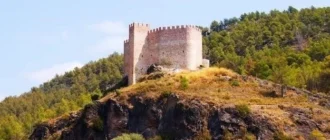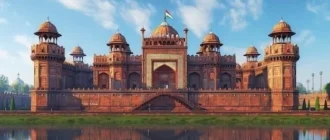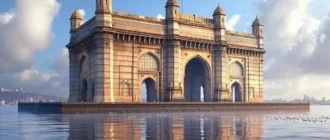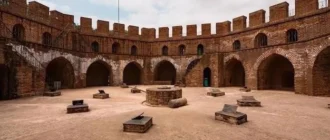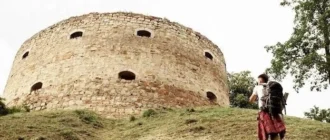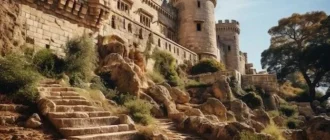Historical Sites in Monrovia: Exploring Liberia’s Rich Past
Monrovia, the capital of Liberia, stands as a testament to the nation’s captivating past. Founded in 1822 by freed American slaves, the city boasts numerous historical sites that narrate the story of Liberia’s founding and its journey to becoming Africa’s oldest republic.

The Founding of Monrovia
The founding of Monrovia is deeply intertwined with the American Colonization Society (ACS), an organization established in the early 19th century with the aim of resettling freed African Americans in Africa. The ACS, driven by a complex mix of motives including abolitionism, colonization, and societal pressures, selected the Pepper Coast of West Africa as the location for their ambitious project.
In 1821, the first group of freed Black Americans, led by Elijah Johnson, arrived on Providence Island at the mouth of the Mesurado River. Facing initial resistance from the indigenous Malinka people, they persevered, establishing a settlement that would eventually become Monrovia. Named in honor of James Monroe, the fifth president of the United States and a prominent supporter of the colonization movement, Monrovia became a beacon of hope and a symbol of self-determination for African Americans seeking refuge from the shackles of slavery and discrimination in the United States.

This historical period is tangibly brought to life when visiting Providence Island. Now connected to the mainland, the island stands as a poignant reminder of the arrival of the settlers. Visitors can explore the remnants of Fort Stockton, built for defense, and the Water Battery, which once housed cannons overlooking the Atlantic. The Providence Island museum further chronicles the journey of these early settlers, showcasing artifacts and documents that illuminate their struggles and triumphs in establishing a foothold on a new continent.
The founding of Monrovia marked a pivotal moment in African history, representing the establishment of the first independent republic on the continent. It serves as a testament to the resilience and determination of those who sought to create a new life for themselves and future generations in the face of adversity. A visit to Providence Island and the historical landmarks that dot Monrovia offers a poignant journey back in time, allowing visitors to trace the footsteps of the city’s founders and gain a deeper understanding of the complexities and significance of Liberia’s origins.

The Significance of Providence Island
Situated at the mouth of the Mesurado River, Providence Island holds a place of profound historical importance in the story of Liberia. Serving as the initial landing site for the first group of freed Black American settlers in 1821, the island stands as a poignant symbol of their arrival and the genesis of a new nation.

Led by Elijah Johnson, these settlers, sponsored by the American Colonization Society, sought refuge and a chance to build a free and independent life far from the oppression they faced in the United States. Providence Island, though small in size, represented a monumental step towards self-determination and the establishment of a nation governed by those who had endured the brutalities of slavery.
Today, Providence Island is no longer an island in the literal sense, having been connected to the mainland of Monrovia. However, its historical significance remains undiminished. The remnants of Fort Stockton, constructed for the defense of the early settlement, and the Water Battery, which once housed cannons guarding the coastline, stand as silent witnesses to the challenges and triumphs faced by these early settlers.
A visit to Providence Island offers a poignant journey back in time. The island houses a museum that provides a captivating glimpse into the lives of those who first set foot on Liberian soil. Through artifacts, documents, and exhibits, visitors can trace the footsteps of these pioneers, understanding their struggles, their resilience, and their unwavering determination to establish a new life for themselves and their descendants. Providence Island serves as a powerful reminder of Liberia’s unique origins and the indelible mark left by those who dared to dream of a brighter future.
The Liberian National Museum: A Glimpse into the Past
Nestled in the heart of Monrovia, the Liberian National Museum stands as the nation’s preeminent institution for the preservation and celebration of Liberia’s rich cultural and historical tapestry. Housed within the historic edifice that once served as the country’s Supreme Court, the museum offers visitors a captivating journey through time, showcasing the diverse narratives that have shaped Liberia’s national identity.
Upon entering the museum, visitors are greeted by a diverse collection of artifacts that span Liberia’s rich past. From pre-colonial relics that attest to the ingenuity and artistic prowess of indigenous communities to poignant reminders of the transatlantic slave trade and the arrival of freed African Americans on Liberian shores, the museum’s exhibits paint a vivid picture of the nation’s multifaceted history.

Exhibits dedicated to Liberia’s political history showcase significant documents, photographs, and personal belongings of past presidents, providing insight into the evolution of the nation’s governance and the individuals who have shaped its course. The museum also proudly displays a remarkable collection of traditional masks, intricately woven textiles, and ceremonial objects, offering a glimpse into the diverse cultural traditions and artistic expressions of Liberia’s many ethnic groups.

A visit to the Liberian National Museum is an essential experience for anyone seeking a deeper understanding of this unique West African nation. Through its carefully curated exhibits and thoughtfully presented narratives, the museum brings Liberia’s past to life, fostering appreciation for its cultural heritage and providing valuable insights into the events and personalities that have shaped its present-day identity.
Architectural Landmarks: Reflecting History
Monrovia’s architectural landscape stands as a testament to its layered history, reflecting influences from its founding as a settlement for freed American slaves to its development as an independent African nation. These architectural landmarks offer tangible connections to the past, providing insights into the city’s evolution and the diverse cultural influences that have shaped its identity.
One such notable landmark is the Sacred Heart Cathedral, an imposing structure located in the heart of Monrovia. Completed in 1935, the cathedral’s distinctive Gothic Revival style, with its soaring arches and intricate stained-glass windows, reflects the influence of European architectural traditions. Serving as the seat of the Catholic Archdiocese of Monrovia, the cathedral stands as a symbol of the city’s religious diversity and the enduring presence of Christianity in Liberian society.
Another architectural gem is the Masonic Temple, an elegant edifice that dates back to the early 20th century. Reflecting the architectural trends prevalent during the period, the Masonic Temple features a blend of Neoclassical and Colonial Revival elements, evident in its symmetrical facade, ornate columns, and prominent pediment. As a gathering place for the Freemasons, a fraternal organization with a long history in Liberia, the Masonic Temple stands as a symbol of the city’s social and intellectual life during a pivotal period in its development.
Scattered throughout Monrovia are other noteworthy structures, including colonial-era buildings with their distinctive verandas and gingerbread trim, as well as examples of Afro-Caribbean architectural styles. These architectural landmarks, each with its own unique story to tell, contribute to the rich tapestry of Monrovia’s urban fabric, offering glimpses into the city’s past and the diverse cultural influences that have shaped its present-day character.

Monrovia’s Role in the Organisation of African Unity
Monrovia holds a significant place in the annals of pan-Africanism, having served as the backdrop for a pivotal moment in the formation of the Organisation of African Unity (OAU), the precursor to the African Union. In 1979, at the height of the Cold War and with the African continent grappling with the remnants of colonialism and the emergence of new challenges, Monrovia hosted the 16th Ordinary Session of the OAU Assembly of Heads of State and Government.
This historic summit, presided over by then-President William R. Tolbert Jr., brought together leaders from across the African continent to deliberate on pressing issues of the day, including the liberation struggles in Southern Africa, the pursuit of economic development, and the promotion of unity and cooperation among African nations. The Monrovia Declaration, a landmark document adopted at the summit, outlined key principles for inter-African relations, emphasizing the importance of peaceful coexistence, non-interference in internal affairs, and the peaceful resolution of disputes.
While the OAU faced its share of challenges in its quest to achieve a fully integrated and prosperous Africa, the Monrovia Summit stands as a testament to the organization’s commitment to dialogue, cooperation, and the pursuit of shared goals. Monrovia’s role in hosting this pivotal summit cemented its place as a significant location in the history of pan-Africanism, showcasing the city’s capacity to serve as a platform for dialogue and cooperation among African leaders.
Modern Monrovia: Balancing History and Progress
Modern-day Monrovia stands at a crossroads, striving to balance the preservation of its rich historical legacy with the demands of a rapidly growing and evolving urban center. The city, having witnessed periods of both triumph and adversity, is embarking on a journey of renewal, embracing progress while cherishing the historical landmarks that bear witness to its resilient spirit.
Amidst the bustling streets and vibrant markets, echoes of the past resonate through the city’s historical sites. Providence Island, the landing site of the first freed American settlers, serves as a poignant reminder of the city’s founding and the enduring quest for freedom and self-determination. The Liberian National Museum stands as a repository of cultural heritage, showcasing the nation’s journey from pre-colonial times to the present day.
As Monrovia grows and modernizes, efforts are underway to preserve these historical treasures, ensuring that future generations can connect with the city’s rich past. Restoration projects, supported by both local and international organizations, aim to breathe new life into aging structures, safeguarding them from the ravages of time and neglect.
However, the task of balancing progress with preservation is not without its challenges. As Monrovia expands, pressure mounts on land use, often pitting the needs of a growing population against the preservation of historical sites. Striking a balance between development and heritage conservation requires careful planning, community engagement, and a shared commitment to honoring the past while building a brighter future.

